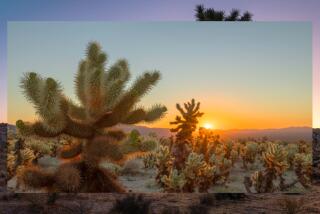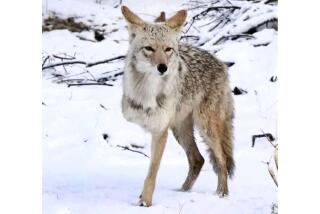Behind the story: Uncovering the history of Minerva Hamilton Hoyt

If you love Joshua Tree National Park, then you should thank Minerva Hamilton Hoyt.
My introduction to desert preservationist Minerva Hamilton Hoyt came in the pages of one of my favorite publications — the pocket-sized, mustard-colored, supposed-to-be-quarterly zine the Desert Oracle.
Under the headline “Apostle of the Cacti,” the Oracle’s writer/editor/publisher Ken Layne wrote a few hundred words about a South Pasadena society hostess who camped in the desert back in the early 20th century and then used her tremendous wealth and influence to create Joshua Tree National Park.
I was stunned. A rich lady from South Pas was the driving force behind my beloved Joshua Tree? How had I never heard of her before? After getting Layne’s blessing, I set out to learn in more detail what drew Hoyt to the desert and how she went about saving it.
In my research I learned there was far more to her story than Layne could squeeze into two pages of his excellent zine.
I started with Joe Zarki, a retired historian of the park who is one of Hoyt’s biggest champions. It was he who commissioned a mural in her honor at the park’s visitor center and got a mountain named after her in the park’s wilderness.
Melanie Spoo, museum curator at the park, helped me dig through old photos, articles and telegrams that the staff had assembled over the years.
Lary Dilsaver, professor emeritus of geography at the University of South Alabama who has written books on six national parks including Joshua Tree, put Hoyt’s achievements in context.
Over the course of my reporting I was startled to see that Hoyt signed her name “Mrs. Sherman A. Hoyt” in almost all her official correspondence around the park. It may have been the style of the day, but this was a powerful, well-connected woman who had been widowed for more than a decade and yet she continued to obscure her own name.
I was also surprised to learn that there is a Sherman Hoyt Avenue in the town of Twentynine Palms but no roads named for Minerva. And although I looked for an obituary on this influential woman in The Times, it seems the paper didn’t think her contributions were important enough to write one.
One of the most thrilling moments of the reporting process was when Spoo emerged from a dark, refrigerated room with a box containing an old photo album. It was a copy of the book Hoyt had sent to President Franklin Delano Roosevelt to persuade him that the California desert was worth protecting.
The images were black-and-white and a bit faded, but otherwise they looked remarkably similar to the ones I take with my phone every time I spend time in the park. Minerva Hamilton Hoyt and I are very different people, separated by time and class, but I believe the beauty of the desert spoke to her in the same way it speaks to me.
More to Read
Start your day right
Sign up for Essential California for news, features and recommendations from the L.A. Times and beyond in your inbox six days a week.
You may occasionally receive promotional content from the Los Angeles Times.







